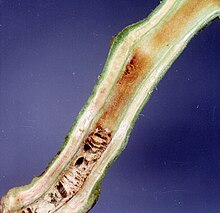Ralstonia solanacearum
| Ralstonia solanacearum | |
|---|---|
 |
|
| Symptoms caused by Ralstonia solanacearum on tomato | |
| Scientific classification | |
| Domain: | Bacteria |
| Phylum: | Proteobacteria |
| Class: | Betaproteobacteria |
| Order: | Burkholderiales |
| Family: | Ralstoniaceae |
| Genus: | Ralstonia |
| Binomial name | |
|
Ralstonia solanacearum (Smith 1896) Yabuuchi et al. 1996 |
|
| Type strain | |
|
ATCC 11696 CCUG 14272 |
|
| Synonyms | |
|
Burkholderia solanacearum (Smith 1896) Yabuuchi et al. 1993 |
|
CCUG 14272
CFBP 2047
DSM 9544
ICMP 5712
JCM 10489
LMG 2299
NCAIM B.01459
NCPPB 325
NRRL B-3212
Burkholderia solanacearum (Smith 1896) Yabuuchi et al. 1993
Bacillus solanacearum Smith 1896
Pseudomonas solanacearum (Smith 1896) Smith 1914 Pseudomonas batatae Cheng and Faan 1962
Pseudomonas ricini (Archibald) Robbs 1954
Ralstonia solanacearum is an aerobic nonspore-forming, Gram-negative, plant pathogenic bacterium. R. solanacearum is soil-borne and motile with a polar flagellar tuft. It colonises the xylem, causing bacterial wilt in a very wide range of potential host plants. It is known as Granville wilt when it occurs in tobacco. Bacterial wilts of tomato, pepper, eggplant, and Irish potato caused by R. solanacearum were among the first diseases that Erwin Frink Smith proved to be caused by a bacterial pathogen. Because of its devastating lethality, R. solanacearum is now of the more intensively studied phytopathogenic bacteria and bacterial wilt of tomato is a model system for investigating mechanisms of pathogenesis.Ralstonia was recently classified as Pseudomonas with similarity in most aspects, except that it does not produce fluorescent pigment like Pseudomonas. The genomes from different strains varies from 5.5 Mb up to 6 Mb, roughly being 3.5 Mb of a chromosome and 2 Mb of a megaplasmid. While the strain GMI1000 was one of the first phytopathogenic bacterias to have its genome completed, the strain UY031 was the first R. solanacearum to have its methylome reported. Within the R. solanacearum species complex, the four major monophyletic clusters of strains are termed phylotypes, that are geographically distinct: phylotypes I-IV are found in Asia, America, Africa, and Oceania, respectively.
...
Wikipedia
